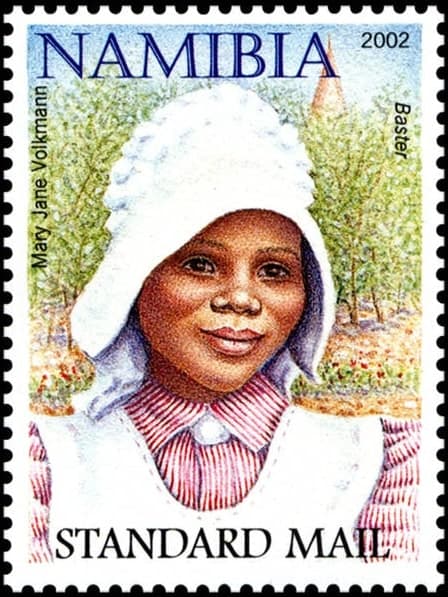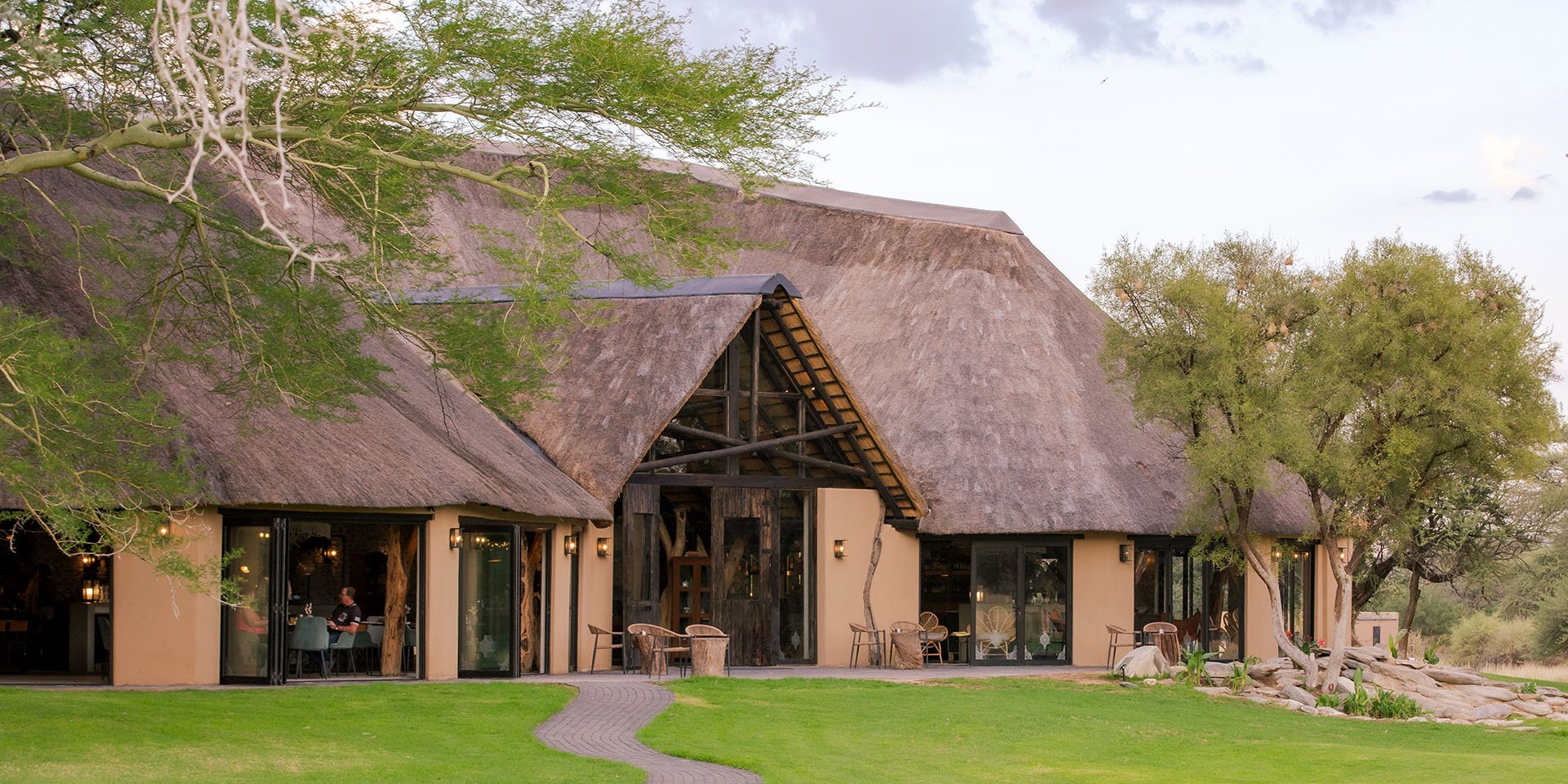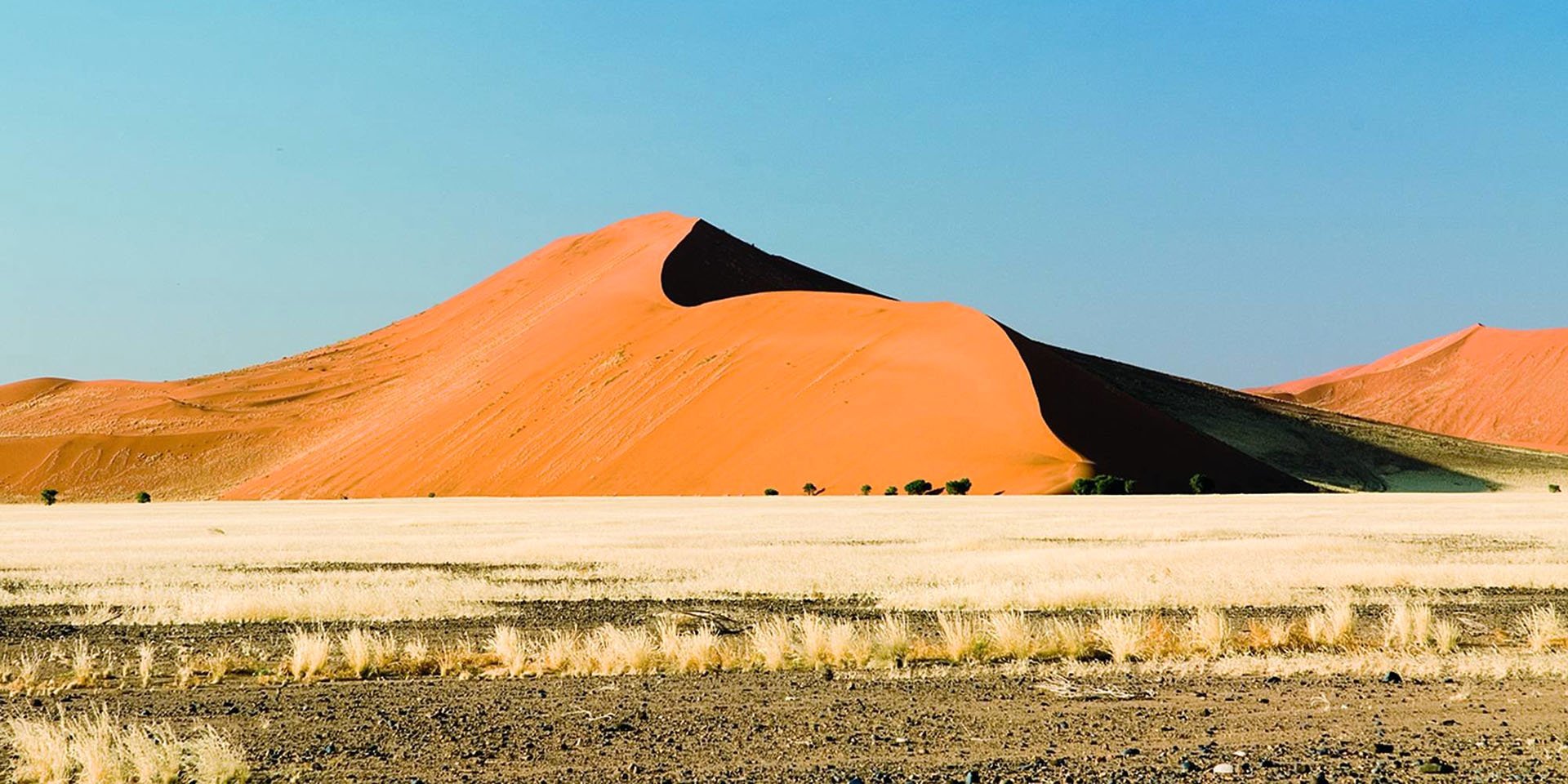Although the long dress and the unique headdress of the Rehoboth Baster women has today disappeared from the everyday scene it is still worn during special ceremonies such as the annual festival commemorating the Baster people’s fallen heroes during the battle of Tsamkhubis, which took place with the German Schutztruppe on May 8, 1915.
NamPost stamp, issued in 2002, artist: Mary Jane Volkmann
The ancestors of the Rehoboth Basters, who were descendents of white fathers and Khoekhoe mothers, originated in the northern frontier districts of the Cape Colony during the first half of the nineteenth century. A mission station was established for them in 1863 at De Tuin, south of the Orange River. It was soon taken over by the missionary Friedrich Heidmann, who was to play a significant role in their further history. Marginalised by increasing numbers of Trek Boers who invaded the area with their large herds of cattle and some marauding groups of San and Koranna, the Basters, accompanied by their missionary, left De Tuin and moved northwards. They crossed the Orange River towards the end of 1868 and inspired by the Nama and Oorlam people, elected Hermanus van Wyk as their “kaptein”.
After a short sojourn at places like Warmbad and Bethanie, a group of about 300 people settled at Rehoboth in 1870. The Basters finally gained ownership of their newly acquired land in 1882 after lengthy negotiations with Abraham Swartbooi, the previous owner of the Rehoboth area and the Special Commissioner of the Cape Government, WC Palgrave.
Various treaties were signed between kaptein Hermanus van Wyk and the German Empire and throughout the Basters remained loyal supporters of the German government. During the war of 1903 to 1907 they made available to the German Schutztruppe some 150 soldiers, transport drivers, wagons, oxen and horses. However, relations between the Germans and the Basters deteriorated dramatically early in 1915 mainly as a result of the Basters fearing that they would lose their land and independence if seen to be openly liaising with the Germans against the invading South Africans. The tragic killing of soldiers and civilians on both sides finally led to the battle at Tsamkhubis in May 1915.
Although women had been excluded from voting in political elections according to the original laws laid down in 1872, they were allowed to do so for the first time in 1924. For the first time in history some 35 “Burger Vrouwens” voiced their grievances on internal affairs and demanded that the Basters be left alone. In spite of women still not being allowed to take on leadership roles, members of the “kappie-commando” played an active role in organising the annual event to commemorate Tsamkhubis and hoisted the Baster flag during the occasion. Most women, especially the elder, would arrive in their long dresses and the characteristic “kappies”.
The particular significance of the dress and headdress is rooted in the Baster’s early history, when they were living amongst early Cape Dutch and Boer settlers in the Cape Province, and from whom many of them originated. The settler wives wore bonnets and “kappies”, which were a combination of 17th century Dutch hoods and 18th century bonnet-shaped caps. These became not only an essential part of the costume of Cape settler wives, but were also adopted by the Baster women as they ideally protected their complexions from the sun.
The original headdress consisted of two parts: a piece of ordinary cloth wrapped around the head and a bonnet, known as “kappie”, which was worn over the cloth. While the ordinary cloth was never removed, the “kappie” was worn whenever a woman appeared in public or when attending church services. Occasionally it was decorated with ostrich feathers. Young girls wore light-coloured, red- or blue-striped “kappies”, while older women preferred dark-coloured ones. “Kappies” and bonnets were painstakingly handmade in a process that took hours. Apparently the high-crowned, so-called “pofbol-kappie” that Voortrekker women wore was often made of white washable linen or cotton. These were most beautifully crafted and textured by fine quilting in simple but attractive patterns, mostly designed by the maker.
In addition, there was the coloured “kappie”, which was similar to the “langbol-kappie” used for formal wear and by older women. It was made from materials that could not be washed. It featured long, full frills at the neck, referred to as “kraag”, which covered the shoulders. It seems that the Baster “kappie” evolved mainly from the “pofbol-kappie”, the “langbol-kappie” and the coloured “kappie” or bonnet. Girls also wore “kappies” from an early age. These were sometimes sewn to their dresses to prevent them from being lost.
The dress worn by Baster women consisted of a long skirt, a blouse and an apron. Usually five or six of these skirts were worn as petticoats to add volume to the garment. The skirts were handmade from cotton, while blouses and belts with attractive buckles were purchased in local shops. Younger women’s aprons were either brightly coloured or white, while older women preferred black.
Some of the ancient “kappies” are kept as heirlooms but many older women still possess the skills to make them according to their grandmothers’ style.
Author: Antje Otto






SUBMIT YOUR COMMENT